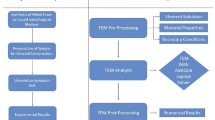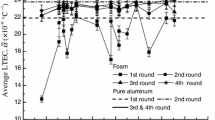Abstract
In this research, the mechanical behavior of closed-cell aluminum (Al)-alloy foams was investigated at different temperatures in the range of 25-450 °C. The main mechanical properties of porous Al-alloy foams are affected by the testing temperature, and they decrease with the increase in the temperature during uniaxial compression. From both the constant/serrated character of stress–strain curves and macro/microstructural morphology of deformed cellular structure, it was found that Al foams present a transition temperature from brittle to ductile behavior around 192 °C. Due to the softening of the cellular structure at higher temperatures, linear correlations of the stress amplitude and that of the absorbed energy with the temperature were proposed. Also, it was observed that the presence of inherent defects like micropores in the foam cell walls induced further local stress concentration which weakens the cellular structure’s strength and crack propagation and cell-wall plastic deformation are the dominant collapse mechanisms. Finally, an energy absorption study was performed and an optimum temperature was proposed.











Similar content being viewed by others
References
L.J. Gibson and M.F. Ashby, Cellular Solids: Structure and Properties, 2nd ed., Cambridge University Press, Cambridge, 1997
E. Linul, L. Marsavina, and J. Kováčik, Collapse Mechanisms of Metal Foam Matrix Composites Under Static And Dynamic Loading Conditions, Mat. Sci. Eng. A, 2017, 690, p 214–224
X.Z. Yue, H. Fukazawa, and K. Kitazono, Strain Rate Sensitivity Of Open-Cell Titanium Foam at Elevated Temperature, Mat. Sci. Eng. A, 2016, 673, p 83–89
M.C. Saha, MdE Kabir, and S. Jeelani, Enhancement in Thermal and Mechanical Properties of Polyurethane Foam Infused with Nanoparticles, Mater. Sci. Eng. A, 2008, 479(1–2), p 213–222
R. Negru, L. Marsavina, T. Voiconi, E. Linul, H. Filipescu, and G. Belciu, Application of TCD for Brittle Fracture of Notched PUR Materials, Theor. Appl. Fract. Mech., 2015, 80, p 87–95
L. Marsavina, F. Berto, R. Negru, D.A. Serban, and E. Linul, An Engineering Approach to Predict Mixed Mode Fracture of PUR Foams Based on ASED and Micromechanical Modelling, Theor. Appl. Fract. Mech., 2017, 91, p 148–154
L. Marsavina, E. Linul, T. Voiconi, D.M. Constantinescu, and D.A. Apostol, On the Crack Path Under Mixed Mode Loading on PUR Foams, Frattura ed Integrita Strutturale, 2015, 34, p 444–453
E. Linul, D.A. Serban, T. Voiconi, L. Marsavina, and T. Sadowski, Energy-Absorption and Efficiency Diagrams of Rigid PUR Foams, Key Eng. Mater., 2014, 601, p 246–249
B. Koohbor and A. Kidane, Design Optimization of Continuously and Discretely Graded Foam Materials for Efficient Energy Absorption, Mater. Des., 2016, 102, p 151–161
S. Mohsenizadeh, R. Alipour, M. Shokri Rad, A. Farokhi Nejad, and Z. Ahmad, Crashworthiness Assessment of Auxetic Foam-Filled Tube Under Quasi-Static Axial, Mater. Des., 2015, 88, p 258–268
L. Marsavina, D.M. Constantinescu, E. Linul, T. Voiconi, and D.A. Apostol, Shear and Mode II, Fracture of PUR Foams, Eng. Fail. Anal., 2015, 58, p 465–476
L. Marsavina, D.M. Constantinescu, E. Linul, F.A. Stuparu, and D.A. Apostol, Experimental and Numerical Crack Paths in PUR Foams, Eng. Fract. Mech., 2016, 167, p 68–83
E. Linul and L. Marsavina, Assesment of Sandwich Beams with Rigid Polyurethane Foam Core Using Failure-Mode Maps, P. Rom. Acad. A, 2015, 16(4), p 522–530
T. Voiconi, E. Linul, L. Marsavina, T. Sadowski, and M. Knec, Determination of Flexural Properties of Rigid PUR Foams Using Digital Image Correlation, Solid State Phenom., 2014, 216, p 116–121
Y. Hangai, T. Morita, S. Koyama, O. Kuwazuru, and N. Yoshikawa, Functionally Graded Aluminum Foam Fabricated by Friction Powder Sintering Process with Traversing Tool, J. Mater. Eng. Perform., 2016. https://doi.org/10.1007/s11665-016-2218-x
Y. Wu, L. Tang, Z. Liu, and X. Zhang, Numerical Study of the Shape Irregularity Gradient in Metallic Foams Under Different Impact Velocities, J. Mater. Eng. Perform., 2017. https://doi.org/10.1007/s11665-017-2777-5
M. Taherishargh, M. Vesenjak, I.V. Belova, T. Fiedler et al., In Situ Manufacturing and Mechanical Properties of Syntactic Foam Filled Tubes, Mater. Des., 2016, 99, p 356–368
J. Lázaro, E. Solórzano, M.A. Rodríguez-Pérez, and A.R. Kennedy, Effect of Solidification Rate on Pore Connectivity of Aluminium Foams And Its Consequences on Mechanical, Mat. Sci. Eng. A, 2016, 672, p 236–246
Z. Liu, Z. Huang, and Q. Qin, Experimental and Theoretical Investigations on Lateral Crushing of Aluminum Foam-Filled Circular Tubes, Compos. Struct., 2017, 175, p 19–27
E.M. Castrodeza, C. Mapelli, M. Vedani et al., Processing of Shape Memory CuZnAl Open-Cell Foam by Molten Metal Infiltration, J. Mater. Eng. Perform., 2009, 18(5–6), p 484–489
I. Mutlu, S. Yeniyol, and E. Oktay, Production and Precipitation Hardening of Beta-Type Ti-35Nb-10Cu Alloy Foam for Implant Applications, J. Mater. Eng. Perform., 2016, 25(4), p 1586–1593
Y. An, S. Yang, E. Zhao, and Z. Wang, Characterization of Metal Grid-Structure Reinforced Aluminum Foam Under Quasi-Static Bending Loads, Compos. Struct., 2017, 178, p 288–296
J. Banhart, Manufacture, Characterisation and Application of Cellular Metals and Metal Foams, Prog. Mater. Sci., 2001, 46, p 559–632
Mu Yongliang and Guangchun Yao, Effect of Fly Ash Particles on the Compressive Properties of Closed-Cell Aluminum Foams, J. Mater. Eng. Perform., 2010, 19, p 995–997
N. Movahedi, S.M.H. Mirbagheri, and S.R. Hoseini, Effect of Foaming Temperature on the Mechanical Properties of Produced Closed-Cell A356 Aluminum Foams with Melting Method, Met. Mater. Int., 2014, 20, p 757–763
S. Fischer, Energy Absorption Efficiency of Open-Cell Pure Aluminum Foams, Mater. Lett., 2016, 184, p 208–210
N. Movahedi and A. Habibolahzadeh, Effect of Plasma Electrolytic Oxidation Treatment on Corrosion Behavior of Closed-Cell Al-A356 Alloy Foam, Mater. Lett., 2016, 164, p 558–561
B. Katona, G. Szebényi, and I.N. Orbulov, Fatigue Properties of Ceramic Hollow Sphere Filled Aluminium Matrix Syntactic Foams, Mat. Sci. Eng. A, 2017, 679, p 350–357
C. Kádár, K. Máthis, I.N. Orbulov, and F. Chmelík, Monitoring the Failure Mechanisms in Metal Matrix Syntactic Foams During Compression by Acoustic Emission, Mater. Lett., 2016, 173, p 31–34
M. Taherishargh, I.V. Belova, G.E. Murch, and T. Fiedler, Pumice/Aluminium Syntactic Foam, Mater. Sci. Eng. A, 2015, 635, p 102–108
D. Luong, V. Shunmugasamy, N. Gupta, D. Lehmhus et al., Quasi-Static and High Strain Rates Compressive Response of Iron and Invar Matrix Syntactic Foams, Mater. Des., 2015, 66, p 516–531
A. Szlancsik, B. Katona, K. Bobor, K. Májlinger, and I.N. Orbulov, Compressive Behaviour of Aluminium Matrix Syntactic Foams Reinforced by Iron Hollow Spheres, Mater. Des., 2015, 83, p 230–237
Y. Alvandi-Tabrizi, D.A. Whisler, H. Kim, and A. Rabiei, High Strain Rate Behavior of Composite Metal Foams, Mat. Sci. Eng. A, 2015, 631, p 248–257
J. Kovácik, J. Jerz, N. Mináriková, L. Marsavina, and E. Linul, Scaling of Compression Strength in Disordered Solids: Metallic Foams, Fratturaed Integrità Strutturale, 2016, 36, p 55–62
M.A. Islam, M.A. Kader, P.J. Hazell, A.D. Brown, M. Saadatfar, M.Z. Quadir, and J.P. Escobedo, Investigation of Microstructural and Mechanical Properties of Cell Walls of Closed-Cell Aluminium Alloy Foams, Mat. Sci. Eng. A, 2016, 666, p 245–256
Z. Zhang, J. Ding, X. Xia, X. Sun, K. Song, W. Zhaoa, and B. Liao, Fabrication and Characterization of Closed-Cell Aluminum Foams with Different Contents of Multi-walled Carbon Nanotubes, Mater. Des., 2015, 88, p 359–365
M.A. Kader, M.A. Islam, M. Saadatfar et al., Macro and Micro Collapse Mechanisms of Closed-Cell Aluminium Foams During Quasi-Static Compression, Mater. Des., 2017, 118, p 11–21
F. Campana, E. Mancini, D. Pilone, and M. Sasso, Strain Rate and Density-Dependent Strength of AlSi7 Alloy Foams, Mat. Sci. Eng. A, 2016, 651, p 657–667
Y. Alvandi-Tabrizi, D.A. Whisler, H. Kim, and A. Rabiei, High Strain Rate Behavior of Composite Metal Foams, Mat. Sci. Eng. A, 2015, 631, p 248–257
M.Y. Omar, C. Xiang, N. Gupta et al., Syntactic Foam Core Metal Matrix Sandwich Composite: Compressive Properties and Strain Rate Effects, Mat. Sci. Eng. A, 2015, 643, p 156–168
Y. Sun, Q.M. Li et al., Investigation of Strain-Rate Effect on the Compressive Behaviour of Closed-Cell Aluminium Foam by 3D Image-Based Modelling, Mater. Des., 2016, 89, p 215–224
P. Wang, S. Xu, Z. Li, J. Yang, C. Zhang, H. Zheng, and S. Hu, Experimental Investigation on the Strain-Rate Effect and Inertia Effect of Closed-Cell Aluminum Foam Subjected to Dynamic Loading, Mat. Sci. Eng. A, 2015, 620, p 253–261
P. Li, N.V. Nguyen, and H. Hao, Dynamic Compressive Behaviour of Mg Foams Manufactured by the Direct Foaming Process, Mater. Des., 2016, 89, p 636–641
T. Jin, Z. Zhou et al., Experimental Study on the Effects of Specimen in-Plane Size on the Mechanical Behavior of Aluminum Hexagonal Honeycombs, Mat. Sci. Eng. A, 2015, 635, p 23–35
L. Marsavina, J. Kovacik, and E. Linul, Experimental Validation of Micromechanical Models for Brittle Aluminium Alloy Foam, Theor. Appl. Fract. Mech., 2016, 83, p 11–18
G. Zu and G. Yao, Influence of Cell Shape Anisotropy on the Compressive Property of Closed-Cell Al-Si Alloy Foam, J. Mater. Eng. Perform., 2012, 21(6), p 985–987
T. Fiedler, M. Taherishargh, L. Krstulović-Opara, and M. Vesenjak, Dynamic Compressive Loading of Expanded Perlite/Aluminum Syntactic Foam, Mat. Sci. Eng. A, 2015, 626, p 296–304
E. Linul, D.A. Şerban, L. Marsavina, and J. Kovacik, Low-Cycle Fatigue Behaviour of Ductile Closed-Cell Aluminium Alloy Foams, Fatig. Fract. Eng. Mater. Struct., 2017, 40(4), p 597–604
L. Wang, N. Limodin, A.E. Bartali, J.F. Witz, R. Seghir, J.Y. Buffiere, and E. Charkaluk, Influence of Pores on Crack Initiation in Monotonic Tensile and Cyclic Loadings in Lost Foam Casting A319 Alloy by Using 3D In Situ Analysis, Mat. Sci. Eng. A, 2016, 673, p 362–372
M. Taherishargh, B. Katona, T. Fiedler, and I.N. Orbulov, Fatigue Properties of Expanded Perlite/Aluminum Syntactic Foams, J. Compos. Mater., 2016, 51(6), p 773–781
J. Liu, Q. Qu, Y. Liu, R. Li, and B. Liu, Compressive Properties of Al-Si-SiC Composite Foams at Elevated Temperatures, J. Alloys. Compd., 2016, 676, p 239–244
M.S. Aly, Behavior of Closed Cell Aluminium Foams Upon Compressive Testing at Elevated Temperatures: Experimental Results, Mater. Lett., 2007, 61(14–15), p 3138–3141
B. Mansoor, H. Nassar, and V.C. Shunmugasamy, Three Dimensional Forming of Compressed Open-Cell Metallic Foams at Elevated Temperatures, Mat. Sci. Eng. A, 2015, 628, p 433–441
J. Kováčik, Ľ. Orovčík, and J. Jerz, High-Temperature Compression of Closed Cell Aluminium Foams, Kovove Mater., 2016, 54, p 429–441
E. Linul, N. Movahedi, and L. Marsavina, The Temperature Effect on the Axial Quasi-Static Compressive Behavior of Ex Situ Aluminum Foam-Filled Tubes, Compos. Struct., 2017, 180, p 709–722
N. Movahedi and E. Linul, Quasi-Static Compressive Behavior of the Ex Situ Aluminum-Alloy Foam-Filled Tubes Under Elevated Temperature Conditions, Mater. Lett., 2017, 206, p 182–184
ISO 13314, Mechanical Testing of Metals—Ductility testing— Compression Test for Porous and Cellular Metals 2011.
L.J. Gibson, Mechanical Behavior of Metallic Foams, An. Rev. Mater. Sci., 2000, 30, p 191–227
A. Şerban, E. Linul, T. Voiconi, L. Marsavina, and N. Modler, Numerical Evaluation of Two-Dimensional Micromechanical Structures of Anisotropic Cellular Materials: Case Study for Polyurethane Rigid Foams, Iran. Polym. J., 2015, 24, p 515–529
I. Duarte, M. Vesenjak, and L. Krstulović-Opara, Compressive Behaviour of Unconstrained and Constrained Integral-Skin Closed-Cell Aluminium Foam, Compos. Struct., 2016, 154, p 231–238
N. Movahedi and S.M.H. Mirbagheri, Comparison of the Energy Absorption of Closed-Cell Aluminum Foam Produced by Various Foaming Agents, Strength Mat., 2016, 48(3), p 444–449
K. Shojaei, S.V. Sajadifar, and G.G. Yapici, On the Mechanical Behavior of Cold Deformed Aluminum 7075 Alloy at Elevatesd Temperatures, Mater. Sci. Eng. A, 2016, 670, p 81–89
S. Sahu, M.D. Goel, D.P. Mondal, and S. Das, High Temperature Compressive Deformation Behavior of ZA27–SiC Foam, Mater. Sci. Eng. A, 2014, 607, p 162–172
I. Duarte, M. Vesenjak, L. Krstulovic-Opara, and Z. Ren, Static and Dynamic Axial Crush Performance of In Situ Foam-Filled Tubes, Compos. Struct., 2015, 124, p 128–139
E. Linul, D.A. Şerban, L. Marsavina, and T. Sadowski, Assessment of Collapse Diagrams of Rigid Polyurethane Foams Under Dynamic Loading Conditions, Arch. Civ. Mech. Eng., 2017, 17(3), p 457–466
Acknowledgments
The authors are grateful to acknowledge of Mr. Cosmin Codrean from Politehnica University of Timisoara for his assistance in performing of microscopic images.
Author information
Authors and Affiliations
Corresponding authors
Rights and permissions
About this article
Cite this article
Movahedi, N., Linul, E. & Marsavina, L. The Temperature Effect on the Compressive Behavior of Closed-Cell Aluminum-Alloy Foams. J. of Materi Eng and Perform 27, 99–108 (2018). https://doi.org/10.1007/s11665-017-3098-4
Received:
Revised:
Published:
Issue Date:
DOI: https://doi.org/10.1007/s11665-017-3098-4




